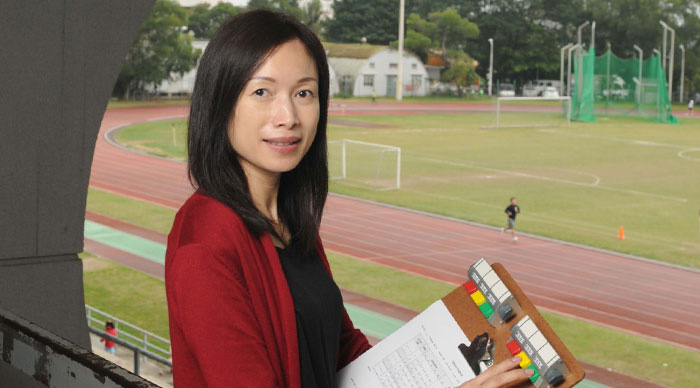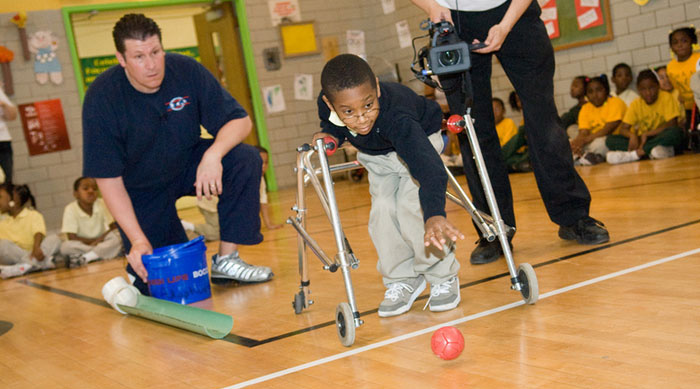Dear readers, With the launch of e-newsletter CUHK in Focus, CUHKUPDates has retired and this site will no longer be updated. To stay abreast of the University’s latest news, please go to https://focus.cuhk.edu.hk. Thank you.
Breaking Down the Barriers: CUHK professor points the way how children with disabilities can stay physically active

Prof. Sit Hui-ping Cindy
Department of Sports Science and Physical Education
'Swimming saved my life—I don't know what I would have done if I hadn't been able to get in the water and compete,' said Margaret McEleny, three-time Paralympic gold medal swimming champion.
Not every person with a disability can be a Paralympic athlete, but he/she can benefit from physical activity. Prof. Sit Hui-ping Cindy in the Department of Sports Science and Physical Education says, 'Physical activity can improve physical fitness in people with disabilities and empower them by improving their self-care abilities, social skills and even self-esteem.'
According to the guidelines issued by the World Health Organization and public health organizations of many countries, children and youths should accumulate at least 60 minutes of moderate- to vigorous-intensity physical activity (MVPA) daily to obtain some health benefits. Most of the research in this field had focused on typically developed children. Children with disabilities are often left off the radar. When Professor Sit published the first paper on sport participation by Hong Kong children with disabilities in Adapted Physical Activity Quarterly in 2002, hers was the first and only research paper on this topic.
Professor Sit had studied social work and worked as a social worker before she shifted her academic focus to sport sciences. With such a background, she was determined to help the underprivileged with her expertise.
According to Professor Sit, activity levels of children with disabilities are affected by individual, social and environmental factors. Individual factors are the types and severity of disability. Social factors refer to the support of parents, teachers, friends or religious groups. She says, 'We concern ourselves with the environmental factors first and hope that the effects of the individual and social factors can be dealt with gradually. So our present studies focus on identifying and breaking down the barriers that children with disabilities encounter in school settings, so as to increase their opportunities for and amount of physical activity.'
In recently years she has used a number of observational tools such as SOFIT (for assessing physical education classes), SOPLAY (for obtaining observational data on students' physical activity levels within specific areas in schools) to study how environmental characteristics of schools affect the physical activity level of children with disabilities. Her research team has assessed those children's physical activity in structured (physical education classes) and unstructured (recesses, lunch breaks, periods before and after school) settings and coded them as sedentary, walking or vigorous. And the environmental characteristics of each target area in schools were recorded in terms of accessibility, usability, and presence of equipment, supervision, and organized activities.
Her studies show that the total weekly minutes of MVPA that the children with disabilities accrued in school were 61.2, only 14.6% of the recommended 420 (60 minutes a day). Professor Sit explains that teachers' instructions and demonstrations used up some of the time in the physical education classes. As a result, the time of MVPA averaged 7.9 minutes. In contrast, when those children played freely and spontaneously during recesses, they engaged in 8.9 minutes of MVPA.

To remedy the situation, she suggests that special schools should increase the frequency and lesson intensity of physical education classes. As for unstructured school time like recesses, lunch breaks, periods before and after school, she believes that the children will be more active if more accessible areas are available and more supervision and organized activities like dancing classes are provided. She says, 'It will be a success if we can help them to accumulate 40 minutes of MVPA during school hours. The remaining 20 minutes can be easily accrued after school.'
Professor Sit's next step is to formulate intervention programmes to facilitate the development of their fundamental movement skills like running, jumping, kicking, catching, and throwing. She says that six to seven years of age is the best age to intervene. She hopes that these programmes can improve the motor abilities of these children, drum up their interest in sport, and most importantly, develop their self-confidence and improve their self-care abilities. She says, 'I've done my research with one objective in mind: to help others to help themselves.'
This article was originally published on CUHK Homepage in May 2015.